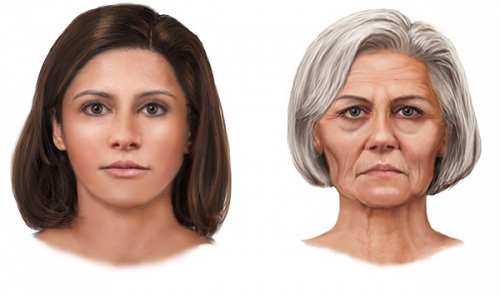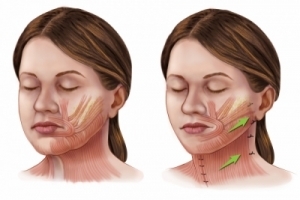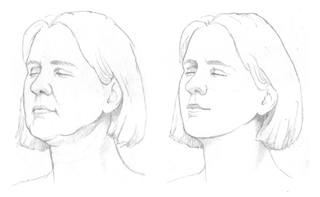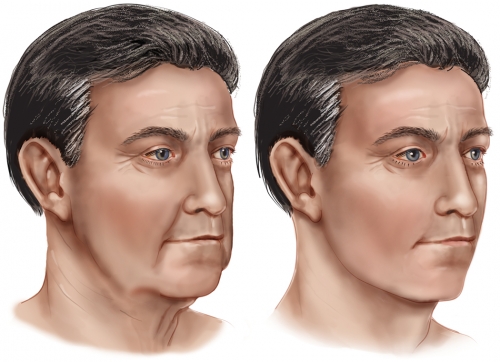"A well done facelift is invisible. Picture yourself, airbrushed. The results must be appropriate not only to your age but also to who and where you are in life, regardless of age."

As we age we notice the firm, smooth, tight character that once defined our appearance begin to slip away. Volume is lost contributing to looseness of tissues and skin. There is a change in the underlying bony structure where rotation and resorption become evident in the eye socket, midface and jawline. Neck bands and jowls become prominent. The skin surface becomes pigmented, wrinkled and more roughly textured. The luminosity of youth departs.
Since we all age at different rates and in different ways, there is no universal age for a facelift. Timing is important for the most benefit possible. Once benefit from surgical enhancement is evident, it is best not to wait too long, yet it’s not advisable to do facial surgery before it is necessary.
Many non-surgical approaches are available for facial rejuvenation. Non-invasive energy-based technologies can help improve mild laxity. Facial fillers restore volume. Lasers improve skin texture and fine lines. It is doubtful however that facelifts will be relegated to surgical history anytime soon. A facelift is still the only repositioning and firming procedure that reliably lifts and tightens the face and neck and corrects the neck bands.
One of the key distinctions between a facelift and non-invasive procedures is that a facelift repositions and firms, but it does not add lost volume. A filler will add volume but is no substitute for tightening. Filling a very loose skin pocket will not result in an aesthetic outcome. In fact, there has been a paradigm shift. The very terms associated with bad facelifts—“overdone,” “tight,” “unnatural” can also be applied to inappropriate use of fillers altering facial shape in an obvious and unaesthetic way characterized by an overfilled, puffy, doughy appearance.
Priorities
THE IMPORTANCE OF “APPROPRIATENESS”
Whether surgical or non-surgical, my priorities are threefold: to maintain aesthetic proportions while staying age and person appropriate. And to synergistically combine surgical and non-surgical techniques in the right dose for an invisible result.
- Aesthetic proportions: must be considered when restructuring the face, whether in surgery or otherwise, for harmonious features that are not off balance or distorted.
- Staying age and person appropriate: Most would agree that wanting to look like a 25 year old at 50 would be absurd and it results in just that: “Wanting” to look like a 25 year old and not actually looking 25 years old. Features change. Looking like one did 25 years ago is not necessarily more attractive at an older age. The same volume that we had at 25 may not look good at 50. Recreating some features of youth is very different from duplicating the same look of a younger time. Whereas some volume repletion as we age looks great, too much of it, will look artificial and strange. The goal should be to look your best regardless of age and not to strive to look younger, just more youthful.
- Aesthetic synergy: The secret is finding the right combination of tightening and volume and not using one to replace the other. The goal is a fresher, softer, and brighter version of our face in the mirror.
DURING YOUR CONSULTATION
A consultation for facial rejuvenation and /or a facelift is necessarily comprehensive. First and foremost, it is a conversation about your motivations and who and where you are in your life cycle. In essence, it is to discuss what your goals are and what you are trying to accomplish.
Second, and one of the most important parts of the consultation, is to understand your aesthetics, and your particular concerns, so that we can work on that basis.
Third, you will also find it is as much a conversation about what a facelift can do as well as what it cannot do. A facelift does not replace lost volume. It will not change the skin’s texture or eliminate all wrinkles and lines. The good news is that there are adjunct procedures that complete the rejuvenation and might include fillers, laser treatments, fat grafting or ultrasound.
Another important and interesting part of the consultation is to get a sense of the aging process in your particular situation. Reviewing serial photographs from youth to the present time is a very helpful exercise and facilitates communication and planning, and is a part of each initial evaluation.
Facelift
HIRMAND TECHNIQUE
Simply put, a facelift should always reposition the deep plane, i.e. the muscle. The skin is not pulled but simply draped over a firmer infrastructure. The closure is meticulous for imperceptible scars. Much like great design and architecture, a great facelift is about precise aesthetic planning and technical implementation for flawless results. It is a misconception that everyone will look pulled or different.
The Deep/SMAS Approach:

The deep/SMAS (superficial muscular facial apenorotic system) approach is the approach I favor for restructuring the face. The SMAS is a connective tissue layer under the skin and fat, which holds the facial muscles and can be safely tightened. Studies have clearly shown the safe SMAS muscle/tissue tightening has the same effectiveness as cutting deeper into the muscle and nerve levels to tighten. This is very important to grasp, as other deeper repositioning techniques have not scientifically shown to result in more natural or longer lasting results, just higher risk levels of nerve injury. On the other hand, studies have in fact shown that skin tightening alone will not last and the deep SMAS level tightening will in fact increase longevity and enhance the outcome.
The facial skeletal structure and shape dictate the exact angles of the SMAS lift and skin tightening in a customized approach. Short scar facelifts are possible for all except those with a heavy neck. Working with shorter scars and multiple vectors—both horizontal and vertical have resulted in the most natural results.
What's the right time?
While a facelift is a procedure done “better late than never” it really has its greatest value when you do it at the right time. The right timing is different for everyone and covers a wide demographic from 45 to 65 and beyond. The right time is when you can benefit from it to correct aging features like jowling and neck looseness and bands but before the skin loses too much elasticity and becomes too loose or thin. The right time is also when you are ready psychologically for it and have time for recovery.
Result-enhancing Adjunct Procedures:
Facial rejuvenation is a symphony. There are many tools to incorporate and combine. Micro- liposuction of neck and jowl fat during surgery has proven to enhance results of repositioning and withstood the test of time. On the other hand, fat grafting, where needed, during surgery is also a strong component of the my contemporary facelift. I favor stem cell enriched fat grafting, which has refined the procedure to the next level. Fillers after surgery are a great adjunct and must be precisely placed. Resurfacing can effectively complement results by eliminating fine lines and wrinkles, brightening texture and pigmentation. All these adjunctive techniques conspire to deliver the softest results.
My mantra is…the right amount of tightening, the right amount of volume and resurfacing… meticulous execution of the aesthetic vision and surgical plan.
Neck & Jawline Lift
HIRMAND TECHNIQUE
It's all about the neck.
Perhaps the most challenging area in rejuvenation, the neck is in constant motion and its skin is often crepier and less elastic than the face. There are multiple components to the aging neck and my strategy is to identify and combine treatment of each of these. A facelift typically includes a necklift.

Fat excess, muscle banding, skin looseness and skin surface issues are the four components in the aging neck. Conserving the right amount of fat is the key to a youthful neck, however for necks with too much fat, conservative micro-suction using very small cannulas, is an essential part of the procedure. The loose visible muscle bands of the neck are tightened in 2 directions—under the chin and also from the sides, resembling a hammock. The skin itself is tightened effectively from the sides. Peel or laser on the skin of the neck is a great finishing touch to improve surface texture and pigmentation. Newer energy technologies like Ulthera have also allowed improvements in firmness before and after necklifts.
It is important to realize that loose inelastic neck skin will “give” and loosen even more if stretched too much, and over-tightening can be counter-productive. Firming neck tissue before surgery can have a theoretic benefit of reducing this kind of tissue “give”. Overall, surgical lifting of the neck results in a beautiful and complete rejuvenation.
A note on isolated neck lifts.
There are indeed a few who could benefit from a necklift without a facelift, though this is the exception rather than the rule. In these situations, the neck is the only area that is treated and the scars are shorter as well. Those who are good candidates have no jowling with changes only in the neck.
Generally, most need to improve their neck along with the lower face otherwise they will not be happy with the result. It may sound counterintuitive but more surgery, ie, in the lower face and jowls, in this case, will make the outcome more harmonious and less visible. Even a small jowl left behind looks out of place and stands out, thereby calling attention to the contrast between what was “done” and what remains..
Some men, in particular, could benefit from an isolated necklift that addresses the heavy hanging neck and just brings the neck into balance with the lower face. More on this in the section below on MEN, an exception…
The Neck/Jawline Lift: a great alternative for some and an emerging trend.
For those who have little to no jowling nor much facial looseness, and donot require tightening in the face, a neck and jawline lift, a less invasive procedure limited to the neck and jawline ,can give very natural and wonderful results. The face is not involved and there is no concern about any internal facial scarring, change in shape or unwanted facelift sequela. The results focus on the neck and it also improves the jawline contour. The scars are also more limited. This procedure is particularly suited to the younger person who has a hereditary tendency to looseness in the neck.
A note on mid-face lifts.
A mid-face lift is a type of facelift where the focus is the central part of the face and intended to vertically lift the cheeks upward. It is commonly performed together with a lower eyelid blepharoplasty and must include precise surgical techniques to avoid change of eye shape or complications. About 10 years ago this was popular and often combined with a facelift to address the middle part of the face and cheeks. With the advent of fillers, it is not as popular nor as necessary.
SURGICAL NOTES
Anesthesia: General
Length of surgery: 4-5 hrs
Outpatient/inpatient outpatient with private duty nursing overnight
Adjunct procedures: fat transfers, chin augmentation, brow lifting, peels
Recovery: initial phase: ten days to two weeks. Count on an additional two weeks to be “camera ready.”
Male Face Lift
HIRMAND TECHNIQUE

Men: An Exception.
The male facelift has unique considerations. A man’s skin is thicker and if the skin is pulled even mildly tight, it will be obvious. In a less than desirable outcome, a woman will look “done” but a man will not only look “done” but feminized—worse than if they had done nothing at all.
My approach to male facial rejuvenation can be described as “soft restructuring” where the work is done primarily on a deep plane and gently re-draping the skin and preserving key landmarks in a man’s features. Scars are the biggest concern for men since they cannot be easily hidden or camouflaged. If meticulously planned and executed and the hairline is taken into account the male facelift can be as invisible an improvement as a woman’s.
Men are also more likely to be able to have isolated necklifts, even with jowls, with the goal of improving significant skin looseness and fat (the infamous “turkey neck” for example), which is hereditary, and bringing the neck into balance with the face without any change in facial appearance.